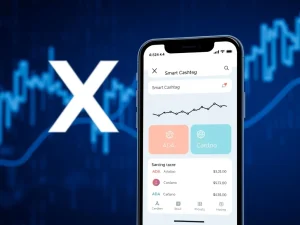Rigorous Crypto KYC: Unveiling Complex Identity Verification Challenges

In the rapidly evolving digital landscape, securing an online account has become a fundamental step for millions. However, the rigor of this process can vary significantly across platforms. Many individuals find themselves questioning why **OnlyFans verification** can feel more arduous than establishing an account on a major cryptocurrency exchange. This paradox reveals a fascinating intersection of compliance, technology, and regulatory pressure across two distinct, yet equally scrutinized, digital industries. This article delves into the nuances of **Crypto KYC** versus adult platform verification, exploring the underlying reasons for these differing experiences and the implications for user trust and regulatory oversight.
Understanding OnlyFans Verification Hurdles
Becoming a creator on platforms like OnlyFans or Pornhub often presents unexpected challenges. The verification process, surprisingly, frequently surpasses the complexity of opening a crypto trading account. While both systems aim to confirm user identities, adult platforms encounter unique obstacles. These hurdles often stem from their specific mandate: preventing minors from publishing explicit content. Therefore, they implement stringent age verification protocols.
Our investigation revealed a common pattern of frustration for aspiring creators. For instance, an application for an OnlyFans creator account faced repeated rejections. The platform demanded an address, multiple document resubmissions, and even social media handles. Despite submitting accurate information and adhering to stated conditions, the application was denied. OnlyFans cited issues with the profile image and selfie, then later claimed provided social media links were invalid, even though they were legitimate. These arbitrary hurdles often leave creators confused and disheartened.
The Struggle for Content Creators
The experience of rejection is not isolated. OnlyFans creator profiles face a notably low acceptance rate. In July, for example, the platform received 184,844 creator applications; only 35% gained approval. This highlights a significant barrier to entry for many. Similarly, Pornhub initially rejected an application, citing only “other” as the reason. A second attempt, using a passport, was approved, coincidentally after a media inquiry.
Joshua Chu, an asset recovery lawyer and co-chair of the Hong Kong Web3 Association, independently confirmed these difficulties. He also attempted to join OnlyFans as a performer. “I looked into joining as a performer, only to find the verification process significantly more rigorous than expected,” Chu stated. “I ultimately didn’t succeed.” His experience underscores the widespread nature of these challenges. He further noted, “During the same period, I’ve opened and verified multiple crypto exchange accounts, including ones not even officially supposed to be operating in Hong Kong, and trading there proved less challenging.” This direct comparison illuminates the perceived disparity in difficulty.
Streamlined Crypto KYC Standards
Conversely, the verification process on major cryptocurrency exchanges often appears more structured and efficient. Platforms such as Coinbase, Bybit, and Bitget primarily focus their checks on financial documentation, source of funds, and proof of address. These requirements align with global anti-money laundering (AML) and counter-terrorist financing (CFT) regulations. Consequently, the process feels more standardized and predictable for users.
Our tests on these platforms demonstrated a distinct approach. Coinbase, for example, began with a Google login and SMS verification. It then asked about employment and the expected source of funds. The exchange required proof of address through documents like a bank statement or utility bill. While an initial bank statement was rejected several times, leading to a 24-hour lock, a July statement was eventually accepted. This shows a clear, albeit sometimes strict, adherence to established financial compliance protocols.
A Closer Look at Exchange Processes
Each crypto exchange implements its **KYC standards** with slight variations. Bybit, for instance, redirected European Union users to its licensed subsidiary. Verification there involved standard ID checks, including a video of a tilted passport to display its hologram. This entire process completed within minutes. Bitget offered the fastest approval, allowing crypto transfers in about 10 minutes after a simple ID upload and selfie. Additional verification for trading crypto against fiat required phone and email codes and a linked bank card. These examples highlight a balance between speed and regulatory compliance.
Hon Ng, Bitget’s chief legal officer, explained their rapid verification process. He noted, “Bitget relies on its eKYC service providers and its review team.” Ng further clarified the distinction between the sectors. “Adult content platforms, on the other hand, often rely on more conservative, sometimes manual or third-party age checks,” he said. These can involve uploaded scans, liveness tests, or credit card checks. He added, “It’s not that adult sites are intentionally more rigorous; often, it’s that the requirements themselves are murkier.” This lack of clarity can contribute to the perceived difficulty.
The Mandate for Robust Identity Verification
Neither adult platforms nor cryptocurrency exchanges always had such stringent identity checks. Both industries significantly tightened their processes after facing major scandals and intense regulatory pressure. These events made the previous, more lenient status quo unsustainable. Consequently, their current **identity verification** frameworks are direct responses to past failures and the demand for greater accountability. This evolution highlights a shared trajectory towards stricter oversight.
Adult Platforms: Responding to Crises
Pornhub underwent a significant overhaul in 2020. This followed a New York Times opinion article exposing underage and non-consensual videos on the site. In response, Visa and Mastercard quickly suspended payment services. The platform subsequently deleted millions of unverified uploads. It then mandated government ID verification for all content creators. OnlyFans faced similar scrutiny in 2021. Its popularity during the pandemic brought increased attention, leading to a BBC News investigation. This investigation revealed minors selling and appearing in explicit videos. The BBC found cases where minors used fake IDs and relatives’ social media profiles to bypass restrictions.
Further demonstrating this intensified scrutiny, in March 2025, the UK communications watchdog Ofcom fined OnlyFans’ parent company, Fenix International. The fine amounted to 1.05 million British pounds (about $1.4 million). Ofcom cited the company for providing inaccurate information about its age-verification system. The regulator had twice requested details in 2022 and 2023 regarding the platform’s “facial age estimation” tool, designed to block minors. These incidents collectively forced adult platforms to significantly enhance their verification protocols.
Crypto Regulation: A Parallel Path to Compliance
Cryptocurrency exchanges followed a parallel, yet distinct, path towards stricter compliance. For many years, platforms like BitMEX and Binance allowed users to trade with minimal or no verification. This approach attracted the strong disapproval of financial regulators worldwide. The lack of robust **crypto regulation** facilitated illicit activities, prompting a global crackdown.
BitMEX became an early example. It settled with US regulators in 2021, agreeing to pay $100 million due to Anti-Money Laundering (AML) and registration failures. In 2024, the exchange pleaded guilty to violating the Bank Secrecy Act. A federal judge imposed another $100-million criminal fine in January 2025, alongside probation. More recently, KuCoin faced similar consequences. In 2025, it pleaded guilty to operating as an unlicensed money transmitter. The exchange agreed to pay nearly $300 million in penalties for optional and inconsistent KYC. These cases underscore the severe repercussions for platforms failing to implement adequate identity checks.
From 2021, the Financial Action Task Force (FATF) updated its global guidance. This applied AML standards directly to crypto assets and service providers. Consequently, exchanges had to adopt KYC rules comparable to traditional banks. This international pressure further solidified the need for comprehensive verification. Joshua Chu emphasized the importance of this. “KYC is crucial for identifying and pursuing bad actors; it’s really the foundation of effective asset recovery work,” he explained. However, he also noted practical shortcomings. “In practice, I’ve observed that some exchanges have gaps in their KYC data or fail to properly verify key documents like address proofs.”
Distinguishing True Compliance from Difficulty in Crypto KYC
The core paradox remains: while onboarding as a creator on an adult site can involve more hoops, this does not automatically equate to superior security or accuracy. The added difficulty in **OnlyFans verification**, for example, often stems from opaque requirements and manual review processes. Conversely, crypto exchanges, despite sometimes appearing simpler, adhere to globally recognized financial regulations. Their systems are built on established frameworks designed to combat financial crime, making them structurally more robust in many aspects.
Hon Ng from Bitget elaborated on this distinction. “For crypto exchanges, KYC is a well-charted, globally familiar process,” he stated. “For age verification in adult content, the rules are newer, interpreted differently across jurisdictions and tangled in privacy debates.” This difference in regulatory maturity significantly impacts the user experience. The clarity of financial regulations provides a more predictable path for crypto users. Meanwhile, the evolving nature of age verification in adult content creates more uncertainty and frustration.
Evolving Landscape of Digital Trust
The integrity of **identity verification** faces new challenges today. “With the rise of AI-generated fakes, these weaknesses have become more pronounced,” Chu warned. This highlights a critical vulnerability across all digital platforms. Although improvements are ongoing, Chu believes that “crypto KYC standards still lag behind traditional finance in integrity and thoroughness.” Both sectors must continually adapt to new technologies and emerging threats. This includes leveraging advanced AI for fraud detection and biometric verification, while also ensuring user privacy.
Ultimately, both adult content platforms and cryptocurrency exchanges share a common trajectory. Their systems tightened only after crises exposed inherent weaknesses. Today’s stricter checks are direct products of lessons learned the hard way. While the specific regulatory pressures differ, the overarching goal remains the same: to build a safer, more accountable digital environment for all users. The ongoing evolution of these verification processes will continue to shape how we interact with digital platforms, emphasizing the critical importance of robust and adaptable compliance frameworks.
Magazine: Astrology could make you a better crypto trader: It has been foretold









